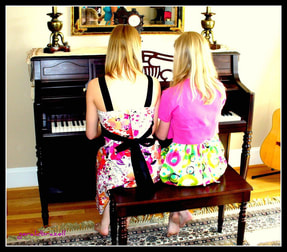
"Medley Magic, Volume 2" features intermediate-level medleys of Christmas favorites with famous Classical melodies, including works by Bach, Mozart, Beethoven, Chopin, Joplin--and more!
Click HERE to see and hear the music from this new collection!
 I am happy to share my newest Composers Community release: a new Christmas songbook! "Medley Magic, Volume 2" features intermediate-level medleys of Christmas favorites with famous Classical melodies, including works by Bach, Mozart, Beethoven, Chopin, Joplin--and more! Click HERE to see and hear the music from this new collection!
0 Comments
 One of my goals as a teacher is to help my students learn how to help themselves! Since most of the work of learning the piano happens outside of their weekly lessons, I want students to have a full "toolbox" of practice techniques they can use at home to help with whatever practice problems may arise. Below are my top 5 favorite general practice techniques--the ones I find myself using over and over with my students. I hope they can be helpful tools for your students, too! 1. Eat the cake! I have blogged previously about my "practice cake" method here. In a nutshell, the practice cake is a visual reminder to help students look for the different layers of information found in their music and learn ways to practice each one. This can be a great way to get students accustomed to goal-oriented practice sessions. For example, one practice session can focus on practicing the rhythm of a piece in several ways: counting and clapping, tapping both hands, counting out loud, using the metronome, etc. Another session could focus on dynamics: finding each marking in the music, mapping out the dynamic "high point" of the piece, practicing sections with quick dynamic changes, etc. I find that practicing with a purpose keeps the brain engaged and makes practice sessions more productive--and more interesting! 2. Post-it practice If students are having problems with a particular area of a piece, I pull out the post-its! Using post-it notes, we cover everything in that section except for the tricky bit. This helps students to really focus in on exactly what is tripping them up. After playing this section several times, we move the post-it back a measure and play again. We keep playing, and moving the post-it note, until the problem section is mastered. 3. Backwards practice Do you have students that master the beginning of a piece, while the ending remains shaky? Enter the backwards practicing technique! "Backwards practice" doesn't mean we literally play the notes backwards; rather, we choose a small section near the end of a piece to practice, then work our way backwards adding one or two measures at a time. This can combine really well with the post-it technique mentioned above! 4. Starting over practice This technique works really well for students that have trouble playing a piece fluidly without mistakes. Starting from the beginning of the piece, we mark several "goalposts" in the music. Students must start from the beginning of the piece and play without mistakes until they reach the first goalpost. If they make a mistake, they must stop and start from the beginning. We work this way on each section until students can successfully play the entire piece without mistakes. This may seem counter-intuitive, since this is the opposite of what we do when we perform! However, I have found that starting over practice really helps students to slow down and think ahead, because they know if they miss a note they must start over! It also prevents mistakes from becoming part of their muscle memory, because students are interrupting the "wrong" movement and starting over from the beginning. 5. Performance practice The opposite of starting over practice, performance practice means we keep going, no matter what! I ask students to get into character and perform a piece from start to finish, just as they would if they were at a recital. Sometimes we can get so caught up in practicing that we forget that the end goal of any piece is to truly perform it--and this takes its own special type of practice to do well! What do you think? Any favorite practice techniques you use with your students? Please share in the comments! Piano Pronto is offering special pricing on my two newest Composers Community hardcopy books!
Pre-order now for just $10, and they ship on July 14th! Click on the covers below to see and hear the music in these books.  Playing the piano can be very lonely. We pianists often spend many hours practicing alone, while our other instrument-playing friends are jamming in concert band or orchestra practice. It doesn't seem fair, does it? It doesn't have to be that way! I love teaching duets because it provides my students with the opportunity to make music with a friend--or sometimes to make a new friend through music! Ensemble playing can help build a sense of camaraderie in your studio--not to mention the benefits to your students' reading and rhythmic skills! I would like to share a few tips that I have found helpful when working on ensemble pieces with my students. With these tips in mind, you and your students will be ready to double the fun with duets!
So, are you ready to double the fun in your studio? Do you work on duets (or trios and quartets) with your students? Please comment below! P.S. Check out some of my own fun duet compositions on my YouTube channel HERE! |
AuthorChrissy Ricker is a pianist, teacher, and composer from North Carolina. These are her thoughts on teaching, composing, and all things music. Looking for teaching ideas related to a specific topic? Use the "search" feature or scroll down to see blog posts organized by category!
Archives
July 2024
Categories
All
|